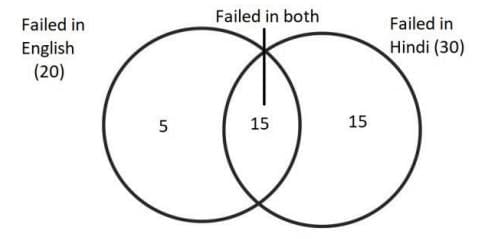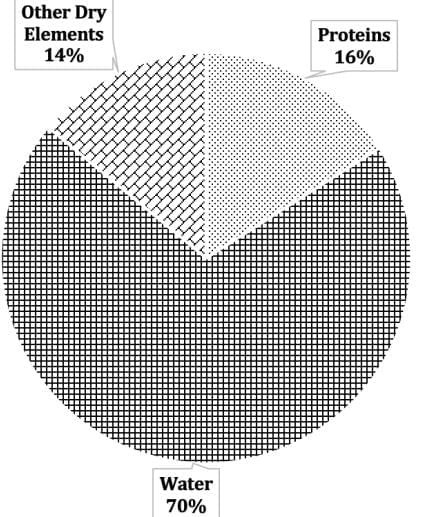Previous Year Topic Wise Questions With Solutions: Percentages | CSAT Preparation - UPSC PDF Download
Note: No questions being asked from this topic in the year 2025
Q1. A number is mistakenly divided by 4 instead of multiplying by 4. What is the percentage change in the result due to this mistake? (2024)
(a) 25%
(b) 50%
(c) 72.75%
(d) 93.75%
 View Answer
View Answer 
Ans: (d)
Let the number be 100.
After multiplying the number by 4, the number will be 4× 100 = 400
But by mistake it was divided by 4. The resultant number will be 100/4 = 25
Required percentage change = {(400 - 25)/400} × 100 = (375/400) × 100 = 93.75%
Q2. In an examination, 80% of students passed in English, 70% of students passed in Hindi and 15% failed in both the subjects. What is the percentage of students who failed in only one subject? (2024)
(a) 15%
(b) 20%
(c) 25%
(d) 35%
 View Answer
View Answer 
Ans: (b)
80% of students passed in English means 20% of students failed in English.
70% of students passed in Hindi means 30% of students failed in Hindi.
We can solve this question by using Venn diagram method: Students that failed in only one subject = Students that failed in only English or those that failed in only Hindi = 5 +15 = 20%
Students that failed in only one subject = Students that failed in only English or those that failed in only Hindi = 5 +15 = 20%
Q3. When 70% of a number x is added to another number y, the sum becomes 165% of the value of y. When 60% of the number x is added to another number z, then the sum becomes 165% of the value of z. which one of the following is correct? (2022)
(a) z < x < y
(b) x < y < z
(c) y < x < z
(d) z < y < x
 View Answer
View Answer 
Ans: (a)
According to the question,
0.7 x + y = 1.65 y
Or 0.7 x = 0.65 y
Or x/y = 0.65/0.70, which is less than 1.
Hence, x < y …..(i)
Now, 0.6 x + z = 1.65 z
Or 0.6 x = 0.65 z
Or x/z = 0.65/0.60, which is greater than 1.
Hence, x > z …..(ii)
From inequalities (i) and (ii), we get: z < x < y
Q4. A pie chart gives the expenditure on five different items A, B, Q D and E in a household. If B, C, D and E correspond to 90o 50o 45o and 75o respectively, then what is the percentage of expenditure on item A? (2022)
(a) 112/9
(b) 125/6
(c) 155/9
(d) 250/9
 View Answer
View Answer 
Ans: (d)
A pie-chart corresponds to 360°.
Items B, C, D and E correspond to 90° , 50°, 45° and 75° respectively on the pie chart.
Angle corresponding to A in the pie-chart = 360° – (90° + 50° + 45° + 75°) = 100°
So, Percentage of expenditure on item A = (100/360) × 100 = (250/9)%
Q5. A pie diagram shows the percentage distribution of proteins, water and other dry elements in the human body. Given that proteins correspond to 16% and water corresponds to 70%. If both proteins and the other dry elements correspond to p%, then what is the central angle of the sector representing p on the pie diagram? (2021)
(a) 54°
(b) 96°
(c) 108°
(d) 120°
 View Answer
View Answer 
Ans: (c)
Percentage of Other Dry Elements in the human body = 100 – (Percentage of Proteins + Percentage of Water) = 100 – (16 + 70) = 100 – 86 = 14%
The following pie-chart represents the scenario described in the question.
So, percentage of both Proteins and Other Dry Elements, i.e. p = 16 + 14 = 30%
In a pie diagram, 100% corresponds to 360°.
So, 30% will correspond to (360/100) × 30 = 108°
That is, the central angle of the sector representing p on the pie diagram = 108°
Q6. If the price of an article is decreased by 20% and then the new price is increased by 25%, then what is the net change in the price? (2021)
(a) 0%
(b) 5% increase
(c) 5% decrease
(d) Cannot be determined due to insufficient data
 View Answer
View Answer 
Ans: (a)
Let the initial price be Rs. 100
New price on decreasing the original price by 20% = 100 – 20% of 100 = 100 – 20 = Rs. 80
Now, the final price on increasing the previous price by 25% = 80 + 25% of 80 = 80 + 20 = Rs. 100
So, there is no net change in price.
Q7. P scored 40 marks more than Q in an examination. If Q scored 10% less marks than P, then how much did Q score. (2021)
(a) 360
(b) 380
(c) 400
(d) 420
 View Answer
View Answer 
Ans: (a)
P scored 40 marks more than Q. So, marks of Q are q, then the marks of P will be q + 40.
Q scored 10% less marks than P. That is, marks of Q are 90% of the marks of P.
So, q = 90% of (q + 40)
Or 10q = 9q + 360
Or q = 360
So, Q scored 360 marks.
Q8. Consider the following Table: (2021) Who is the fastest run scorer in the Test Match?
Who is the fastest run scorer in the Test Match?
(a) A
(b) B
(c) C
(d) D
 View Answer
View Answer 
Ans: (b)
Fastest run scorer means the batsman that has the best runs scored : balls faced ratio.
For batsman A: Runs scored : Balls faced = 75/175 = 0.43
For batsman B: Runs scored : Balls faced = 55/97 = 0.57
For batsman C: Runs scored : Balls faced = 35/125 = 0.28
For batsman D: Runs scored : Balls faced = 25/105 = 0.24
The best ratio is that of batsman B.
|
205 videos|264 docs|136 tests
|
FAQs on Previous Year Topic Wise Questions With Solutions: Percentages - CSAT Preparation - UPSC
| 1. What are percentages and how are they used in daily life? |  |
| 2. How do you calculate a percentage of a given number? |  |
| 3. What is the difference between percentage increase and percentage decrease? |  |
| 4. How can percentages be applied in financial literacy? |  |
| 5. What are some common mistakes to avoid when working with percentages? |  |
















